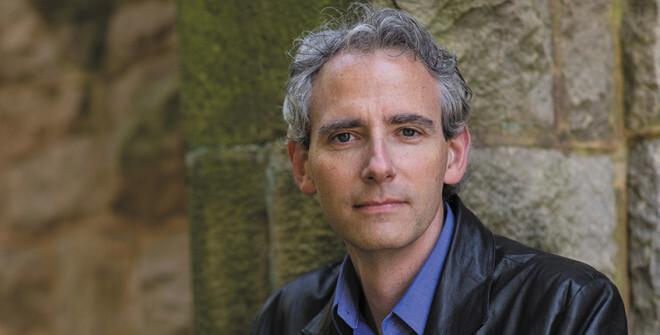While today’s students use PDF files and watch video documentaries, one professor maintains that an often overlooked medium plays a key role in human history — parchment, the thin material made from animal skin.
Bruce Holsinger, a professor and researcher at the University of Virginia, gave the 2023 Lacay Lecture, co-hosted by the Georgetown University Humanities Initiative and the departments of English and global medieval studies. Holsinger, who specializes in pre-modern literary history and culture, spoke about his most recent publication, “On Parchment: Animals, Archives, and the Making of Culture from Herodotus to the Digital Age,” which delves into the role of animal skins in writing, arts and culture.
Holsinger combined his expertise in medieval cultural studies with that of scientific experts in conservation and bioarchaeology to develop the concept for his book and the Lacay Lecture.
Sarah McNamer, a professor and the director of the global medieval studies program at Georgetown who introduced Holsinger at the event, said his work transcends the boundaries of any one field.
“Professor Holsinger’s work is so rich and varied that it’s difficult to sum him up in any succinct way,” McNamer said at the event. “But we might start by describing him as a specialist in the literature and culture of the medieval world.”
McNamer, also a medieval scholar, said Holsinger’s work helps dissect the inconvenient, and often problematic, role of human-animal interactions in chronicling human history.
“It is a typical Bruce Holsinger impulse to move towards such problems, boldly leading us into new interdisciplinary territory and helping us to see the manifold ways in which humans have literally enrolled animals in the task of memorializing the past,” McNamer said.
Holsinger said that without the use of animal skins in writing, specifically parchment, much of human history before the use of paper would have been lost to time.

“For well over a thousand years, the societies of the Euro-Mediterranean world transmitted and preserved much of their written cultures on the skins of animals,” Holsinger said. “If it were not for the countless beasts whose hides served these and other scribes and illuminators over many centuries, we might now possess only fragments of ancient culture.”
Holsinger said embracing multiple academic disciplines was key in his research and writing processes. Holsinger said it is challenging to maintain the unique identities of the many worlds that he studies.
“One of the challenges entailed in writing a book about parchment is that indeed, one of the medium’s own provocations came in engaging these distinctive cultures on their own terms without sacrificing their methodological specificity or their specialized idioms in the name of a flattening interdisciplinarity,” Holsinger said.
Holsinger recounted the scientific aspect of the research that he participated in, including the intricate process of extracting molecules from precious ancient manuscripts to study their parchment without damaging their structural integrity.
To solve this unique problem, Holsinger said scientists he worked with, specifically archaeology expert Sarah Fiddyment, used pencil erasers to clean the 1,000-year-old York Gospels without physically altering any of the documents.
“How can you justify cutting up a priceless manuscript for biomolecules? How can sampling be done at a scale that would make such inquiries worthwhile?” Holsinger said, referring to Fiddyment. “She does so not by sacrilegiously snipping off a corner of a Chaucer manuscript, but by using the very waste produced by conservationists around the world working to clean and restore membrane documents.”
Following his remarks at the event, Holsinger participated in an interview with The Hoya.
Holsinger said he takes advantage of the wide array of parchment manuscripts that have been made available online in the 21st century.
“Many of them already are digitized,” Holsinger told The Hoya. “There’s massive amounts of digitization that have happened in the last 20 years. I teach from digitized manuscripts all the time, and there’s already so much out there.”
Holsinger said that while the use of parchment seems worlds away to students in this modern day and age, the influence of the material is both timeless and meaningful to Georgetown.
“Georgetown is a Jesuit school, and the Jesuits were great leaders of manuscripts and were great students of medieval theology, most of which survives on parchment,” Holsinger said. “It’s always going to be relevant as part of the intellectual tradition of the school.”





















